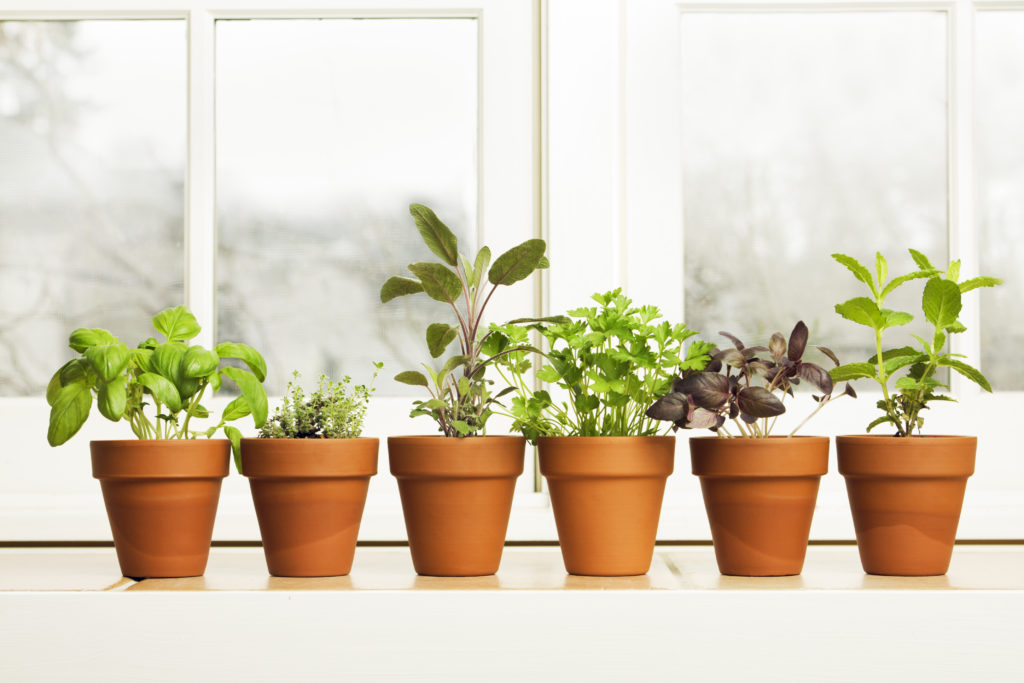How To Plant An Herb Garden—Right In Your Kitchen Window
- Published: Wednesday, June 15th 2016
- in Living Well

By Erin Vaughan
Here’s a common kitchen dilemma: You spend five dollars on herbs to add to a new recipe you want to try. After begrudgingly forking over your hard-earned cash for a packet of tarragon, you use a mere fifth of it to make your French-herbed chicken—which turns out to be delicious. Satisfied sighs all around the table. But what about all that extra tarragon, left in your fridge to wither and mold? Seems like a waste, right? And what if you’re hoping to cook fresh every night? Do you need to shell out half of your grocery budget for a few sprigs of green?
Not necessarily. Herbs are actually some of the easiest plants to grow—most need nothing more than a pot, a sunny spot on a window, and some water here and there. And they can perk up a dish like no other—there’s no substitute for fresh basil on a Caprese salad or Margherita pizza. Here’s how you can put some zip in your dishes, save a few dollars, and add a little green to your kitchen by installing a window herb garden.
A quick guide to the herbs: The best way to begin your journey into herb ownership is to get familiar with the growing habits and flavor profiles of a few common herbs. Here are some that home cooks love:
- Basil: One of the most versatile of aromatic herbs, basil can add pep to a salad or fill out a stir fry, is perfect in almost all Italian dishes, and makes a flavorful pizza topping. It likes a sun-drenched spot and lots of humidity—so it would be happy to have a spritz from a spray bottle here and there. It also dries out fast, so make sure not to skip the watering on this one.
- Oregano: Another one of the Italian greats, oregano adds a special something to red sauces. It likes well-drained soil and lots of sun. Pinch leaves from the top of the plant to encourage new growth.
- Rosemary: Rosemary adds complexity to chicken dishes and goes great with roasted vegetables. Overwatering will kill it fast, so allow it to almost completely dry out before fetching the watering can.
- Sage: Another arid-hailing plant, sage also prefers dry, well-drained soils. Try it in sausages and stuffings.
- Mint: Mint grows like a weed and is a hearty, sturdy plant for you black thumbs out there. It makes a refreshing tea, livens up lamb, and adds fresh notes to Thai dishes.
- Thyme: Thyme lends a fragrant taste to vegetable dishes and French cuisine. It likes a little room to spread out, as it’s a low-growing ground cover, rather than a tall climber.
- Chives: Chives make a delicious topping for baked potatoes, bagels with cream cheese, and creamy soups. They like nutritious well-drained soil, with frequent watering.
- Tarragon: Star of French cooking, tarragon brings balance to chicken salads and roasts alike, and can be a great additive to homemade dressings. It does well in larger pots that are at least ten inches deep, with well-drained soil, placed in a sunny spot.
You can also choose to grow parsley, cilantro, and dill—but these species are annuals that don’t continue growing once harvested. Plus, they’re usually on the less expensive side at the store, so they might be better off purchased there.
Examine your window and environment:
- Aim for a window infused with sunlight throughout much of the day—those that face East or South will be best for these purposes.
- Check out the width of your window sill. If the sill is narrow, smaller than say, four to five inches, then you’ll want to install a supplemental shelf below it—or get creative, and hang your pots from the ceiling, or bolt them into a nearby wall.
- Lastly, consider the temperature and airflow by your window. Plants will do best in temperatures that range between 55 and 75 degrees, so if your window gets chilly in winter, you may want to invest in some insulation. Herbs also prefer a spot with good air circulation, so turn on the fan, if you must.
Selecting your pots and soil: Almost any pot is suitable for herb growing, as long as it is at least six inches deep, except where noted in the herb guide above. For soil, be sure to choose a mix that contains lightweight ingredients like vermiculite, such as potting soil, which will keep the dirt from compacting.
Caring for your plants: Different herbs have varying needs regarding watering, but generally, rosemary, sage, and thyme prefer slightly drier soils, whereas basil, chives, and mint like it moist, and may even benefit from a gentle misting with a spray bottle. To check the soil, stick a finger one inch deep and feel the moisture level. After several months, you may also need to refresh the plant with fertilizer, as nutrients in containers can be washed away from frequent watering. Beyond that, all that’s left to do is enjoy the beauty, fragrance, and flavor of fresh herbs, just a short walk away from your kitchen stove!
Erin Vaughan is a blogger, gardener and aspiring homeowner. She currently resides in Austin, TX where she writes full time for Modernize.com, with the goal of empowering homeowners with the expert guidance and educational tools they need to take on big home projects with confidence.


